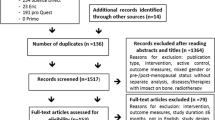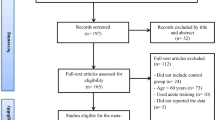Abstract
Introduction
Exercise has been recommended to increase bone mass and prevent osteoporosis. While current treatment of osteoporosis mainly involves the use of antiresorptive agents, it is unclear whether there are any additive effects in improving bone mass when antiresorptive agents and exercise are jointly used.
Methods
A structured and comprehensive search of databases was undertaken along with hand searching of key journals and reference lists. The combined interventions of antiresorptive agents and exercise were examined for their additive effects on lumbar spine bone mineral density (BMD) among adults with low bone mass. Trial quality was assessed using the Jadad quality score. Study outcomes for analysis, absolute change (grams per square centimeter) or relative change (in percent) in BMD, at the lumbar spine were compared by calculating standardized mean difference (SMD) using fixed and random effect models.
Results
Seven randomized controlled trials (RCT) met the predetermined inclusion criteria. The increase in lumbar spine BMD of the combined-intervention group was significantly greater than that of the antiresorptive agent-alone group (fixed effect model: SMD = 0.55; 95 % confidence interval (CI) = 0.36, 0.75; overall effect Z-value = 5.51; p < 0.00001). Subgroup analyses also showed consistent results. Methodological quality of most included studies was scored 3 by the Jadad criterion, and publication bias was slight according to funnel plots.
Conclusion
It was found that combining antiresorptive agents with exercise had additive effects on improving lumbar spine bone mass gains in adults with low bone mass. To verify the additive effects further, more RCTs with longer duration and larger sample sizes are needed.






Similar content being viewed by others
References
(1993) Consensus development conference: diagnosis, prophylaxis, and treatment of osteoporosis. Am J Med 94: 646–650. doi:10.1016/0002-9343(93)90218-E
Rachner TD, Khosla S, Hofbauer LC (2011) Osteoporosis: now and the future. Lancet 377(9773):1276–1287. doi:10.1016/S0140-6736(10)62349-5
Black DM, Cummings SR, Karpf DB (1996) Randomised trial of effect of alendronate on risk of fracture in women with existing vertebral fractures. Lancet 348:1535–1541. doi:10.1016/S0140-6736(96)07088-2
Lieberman U, Weiss SR, Broll J (1995) Effect of oral alendronate on bone mineral density and the incidence of fractures in postmenopausal osteoporosis. N Engl J Med 333:1437–1443
Harris ST, Watts NB, Genant HK, McKeever CD, Hangartner T et al (1999) Effects of risedronate treatment on vertebral and nonvertebral fractures in women with postmenopausal osteoporosis: a randomized controlled trial. Vertebral Efficacy with Risedronate Therapy (VERT) Study Group. JAMA 282:1344–1352
Rabenda V, Mertens R, Fabri V, Vanoverloop J, Sumkay F et al (2008) Adherence to bisphosphonates therapy and hip fracture risk in osteoporotic women. Osteoporos Int 19(6):811–818. doi:10.1007/s00198-007-0506-x
Cramer JA, Gold D, Silverman S, Lewiecki EM (2007) A systematic review of persistence and compliance with bisphosphonates for osteoporosis. Osteoporos Int 18:1023–1031. doi:10.1007/s00198-006-0322-8
Kennel KA, Drake MT (2009) Adverse effects of bisphosphonates: implications for osteoporosis management. Mayo Clin Proc 84(7):632–637. doi:10.1016/S0025-6196(11)60752-0, quiz 638
Woo SB, Hellstein JW, Kalmar JR (2006) Systematic review bisphosphonates and osteonecrosis of the jaws. Ann Intern Med 144(10):753–761
Odvina CV, Zerwekh JE, Rao DS, Maalouf N, Gottschalk FA, Pak CY (2005) Severely suppressed bone turnover: a potential complication of alendronate therapy. J Clin Endocrinol Metab 90:1294–1301. doi:10.1210/jc.2004-0952
Lenart BA, Lorich DG, Lane JM (2008) Atypical fractures of the femoral diaphysis in postmenopausal women taking alendronate. N Engl J Med 358(12):1304–1306. doi:10.1056/NEJMc0707493
Dalsky GP, Stocke KS, Eshani AA, Slatopolsky WC, Lee WC, Birge SJ (1988) Weight-bearing exercise training and lumbar bone mineral content in postmenopausal women. Ann Intern Med 108(6):824–828
Howe TE, Shea B, Dawson LJ, Downie F, Murray A et al (2011) Exercise for preventing and treating osteoporosis in postmenopausal women. Cochrane Database Syst Rev 7, CD000333. doi:10.1002/14651858
de Kam D, Smulders E, Weerdesteyn V, Smits-Engelsman BC (2009) Exercise interventions to reduce fall-related fractures and their risk factors in individuals with low bone density: a systematic review of randomized controlled trials. Osteoporos Int 20(12):2111–2125. doi:10.1007/s00198-009-0938-6
Martyn-St James M, Carroll S (2006) High-intensity resistance training and postmenopausal bone loss: a meta-analysis. Osteoporos Int 17(8):1225–1240. doi:10.1007/s00198-006-0083-4
Nelson ME, Fiatarone MA, Morganti CM, Trice I, Greenberg RA, Evans WJ (1994) Effects of high-intensity strength training on multiple risk factors for osteoporotic fractures. A randomized controlled trial. JAMA 272:1909–1914
Prince RL, Smith M, Dick IM et al (1991) Prevention of postmenopausal osteoporosis—a comparative study of exercise, calcium supplementation, and hormone-replacement therapy. N Engl J Med 325:1189–1195
Jones HH, Priest JD, Hayes WC, Tichenor CC, Nagel DA (1977) Humeral hypertrophy in response to exercise. J Bone Joint Surg Am 59:204–208. doi:10.2106/JBJS.G.00853
Raab-Cullen DM, Thiede MA, Peterson DN, Kimmel DB, Recker RR (1994) Mechanical loading stimulates rapid changes in periosteal gene expression. Calcif Tissue Int 55:473–478. doi:10.1007/BF00298562
Haapasalo H, Sievanen H, Kannus P, Heinonen A, Oja P, Vuori I (1996) Dimensions and estimated mechanical characteristics of the humerus after long-term tennis loading. J Bone Miner Res 11(6):864–872
Braith RW, Magyari PM, Fulton MN, Aranda J, Walker T, Hill JA (2003) Resistance exercise training and alendronate reverse glucocorticoid-induced osteoporosis in heart transplant recipients. J Heart Lung Transplant 22(10):1082–1090. doi:10.1016/S1053-2498(02)01184-1
Braith RW, Conner JA, Fulton MN, Lisor CF, Casey DP, Howe KS, Baz MA (2007) Comparison of alendronate vs alendronate plus mechanical loading as prophylaxis for osteoporosis in lung transplant recipients: a pilot study. J Heart Lung Transplant 26(2):132–137. doi:10.1016/j.healun.2006.11.004
Notelovitz M, Martin D, Tesar R, Khan FY, Probart C et al (1991) Estrogen therapy and variable-resistance weight training increase bone mineral in surgically menopausal women. J Bone Miner Res 6(6):583–590
Villareal DT, Binder EF, Yarasheski KE, Williams DB, Brown M et al (2003) Effects of exercise training added to ongoing hormone replacement therapy on bone mineral density in frail elderly women. J Am Geriatr Soc 51(7):985–990. doi:10.1046/j.1365-2389.2003.51312.x
Iwamoto J, Takeda T, Sato Y, Uzawa M (2005) Effect of whole-body vibration exercise on lumbar bone mineral density, bone turnover, and chronic back pain in post-menopausal osteoporotic women treated with alendronate. Aging Clin Exp Res 17(2):157–163
Waltman NL, Twiss JJ, Ott CD, Gross GJ, Lindsey AM et al (2010) The effect of weight training on bone mineral density and bone turnover in postmenopausal breast cancer survivors with bone loss: a 24-month randomized controlled trial. Osteoporos Int 21(8):1361–1369. doi:10.1007/s00198-009-1083-y
Maddalozzo GF, Widrick JJ, Cardinal BJ, Winters-Stone KM, Hoffman MA, Snow CM (2007) The effects of hormone replacement therapy and resistance training on spine bone mineral density in early postmenopausal women. Bone 40(5):1244–1251. doi:10.1016/j.bone.2006.12.059
Papaioannou A, Morin S, Cheung AM, Atkinson S, Brown JP et al (2010) 2010 clinical practice guidelines for the diagnosis and management of osteoporosis in Canada: summary. CMAJ 182:1864–1873. doi:10.1503/cmaj.100771
Jadad AR, Moore RA, Carroll D, Jenkinson C, Reynolds DJM, Gavaghan DJ, McQuay HJ (1996) Assessing the quality of reports of randomized clinical trials: is blinding necessary? Control Clin Trials 17:1–12. doi:10.1016/0197-2456(95)00134-4
Review Manager (RevMan) Version 5.1. Computer program (2011) The Nordic Cochrane Centre. Cochrane Collaboration, Copenhagen
Egger M, Davey SG, Schneider M, Minder C (1997) Bias in meta-analysis detected by a simple, graphical test. BMJ 315:629–634
Adachi JD (1996) Current treatment options for osteoporosis. J Rheumatol 23:11–14
Yeh JK, Aloia JF, Chen MM et al (1993) Influence of exercise on cancellous bone of the aged female rat. J Bone Miner Res 8:1117–1125
Chen MM, Yeh JK, Aloia JF et al (1994) Effect of treadmill exercise on tibial cortical bone in aged female rats: a histomorphometry and dual energy X-ray absorptiometry study. Bone 15:313–319
Uusi-Rasi K, Kannus P, Cheng S, Sievänen H, Pasanen M et al (2003) Effect of alendronate and exercise on bone and physical performance of postmenopausal women: a randomized controlled trial. Bone 33(1):132–143. doi:10.1016/S8756-3282(03)00082-6
van Schoor NM, Deville WL, Bouter LM, Lips P (2002) Acceptance and compliance with external hip protectors: a systematic review of the literature. Osteoporos Int 13:917–924. doi:10.1007/s001980200128
Nishimura J, Ikuyama S (2000) Glucocorticoid-induced osteoporosis: pathogenesis and management. J Bone Miner Metab 18(6):350–352. doi:10.1007/s007740070008
Kelley GA, Kelley KS (2004) Efficacy of resistance exercise on lumbar spine and femoral neck bone mineral density in premenopausal women: a meta-analysis of individual patient data. J Women’s Health (Larchmt) 13(3):293–300
Pruitt LA, Taaffe DR, Marcus R (1995) Effects of a one-year high-intensity versus low-intensity resistance training program on bone mineral density in older women. J Bone Miner Res 10:1788–1795
Cummings SR, Black DM, Nevitt MC (1993) Bone density at various sites for prediction of hip fractures. Lancet 341:72–75. doi:10.1016/0140-6736(93)92555-8
Lespessailles E, Jaffré C, Beaupied H, Nanyan P, Dolléans E et al (2009) Does exercise modify the effects of zoledronic acid on bone mass, microarchitecture, biomechanics, and turnover in ovariectomized rats. Calcif Tissue Int 85(2):146–157. doi:10.1007/s00223-009-9269-z
Jee WS, Tian XY (2005) The benefit of combining non-mechanical agents with mechanical loading: a perspective based on the Utah Paradigm of Skeletal Physiology. J Musculoskelet Neuronal Interact 5(2):110–118
Sterne JAC, Egger M, Davey Smith G (2001) Investigating and dealing with publication and other biases. In: Egger M, Davey Smith G, Altman DG (eds) Systematic reviews in health care. Meta-analysis in context. BMJ Publishing Group, London, UK, pp 189–208
Begg CB, Cho M, Eastwood S, Horton R, Moher D et al (1996) Improving the quality of reporting of randomized controlled trials. The CONSORT statement. JAMA 276(8):637–639
Polidoulis I, Beyene J, Cheung AM (2012) The effect of exercise on pQCT parameters of bone structure and strength in postmenopausal women—a systematic review and meta-analysis of randomized controlled trials. Osteoporos Int 23(1):39–51. doi:10.1007/s00198-011-1734-7
Montori VM, Guyatt GH (2001) Intention-to-treat principle. CMAJ 165(10):1339–1341
Conflicts of interest
None.
Author information
Authors and Affiliations
Corresponding author
Additional information
Dr. Rui Gao and Dr. Jiehong Zhang contributed equally to this work and should be considered as co-first authors.
Dr. Peng Cao and Prof. Wen Yuan contributed equally to this work and should be considered as co-corresponding authors.
Rights and permissions
About this article
Cite this article
Zhang, J., Gao, R., Cao, P. et al. Additive effects of antiresorptive agents and exercise on lumbar spine bone mineral density in adults with low bone mass: a meta-analysis. Osteoporos Int 25, 1585–1594 (2014). https://doi.org/10.1007/s00198-014-2644-2
Received:
Accepted:
Published:
Issue Date:
DOI: https://doi.org/10.1007/s00198-014-2644-2




